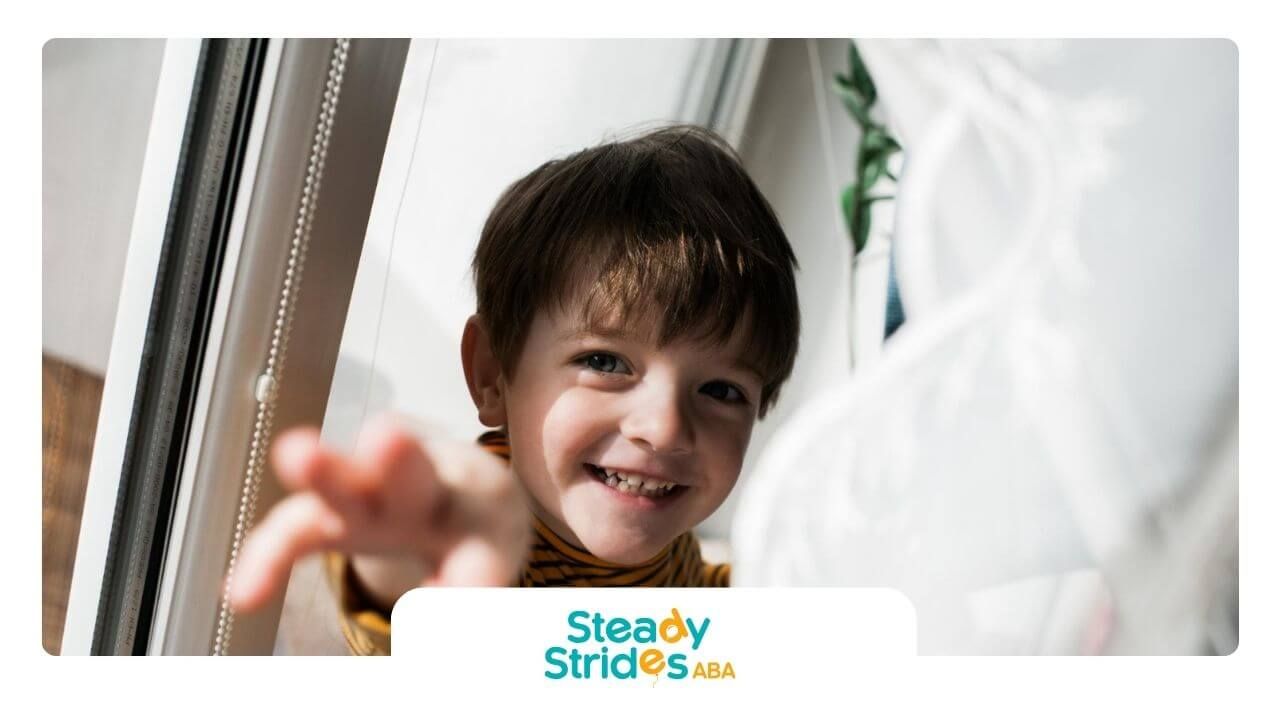Key Highlights
- Ensuring a safe home environment for children on the autism spectrum involves addressing unique challenges like sensory sensitivities and wandering.
- Identifying specific safety risks in different areas of the home is critical for proactive child-proofing.
- Tailored safety approaches with input from family members and positive reinforcement create more secure and supportive settings.
- Modifications such as securing furniture, using sensory-friendly lighting, and installing safety locks greatly enhance home safety.
- Technology like alarms, visual aids, and tracking devices can serve as excellent tools for autism-specific home security.
Ensuring your home is a safe haven for a child with autism requires more than traditional child-proofing—it calls for tailored strategies that address sensory sensitivities and unique behaviors.
Over the years, I have guided many families through this process through home-based ABA therapy in Texas. One mother shared how securing furniture and adding sensory-friendly lighting helped reduce her son’s anxiety and prevented accidents.
In this article, we'll explore essential home safety tips designed specifically to keep your child secure and comfortable.
Understanding Autism and Home Safety Challenges
Creating a safe home for children with autism is not the same as basic child-proofing. Many kids on the autism spectrum like to touch and play with things.
They often get very interested in certain objects, which can make accidents happen more often at home. These kids are usually very curious. They also react more strongly to sights, sounds, and textures in the home. Because of this, parents face a special set of problems.
Sometimes, children with autism will leave the house without warning. This wandering or elopement can happen on a regular basis, which makes things even more difficult. To keep them safe, you need to look at the child’s environment closely. Then, you can make changes that fit their needs. It is important for all of us to work together and find the best ways to protect them.
Identifying common safety risks for children with autism
Safety risks change in different areas of the home and can depend on each child and what they do. For example, children with autism might go into places when no one is watching them. This means they can come in contact with sharp objects, dangerous chemicals, or uncovered electrical outlets. Kitchens and bathrooms in the home are some of the places with high risk.
Some children on the autism spectrum are drawn to things that make strong sounds or sights like water, fire, and fans. They may not know these things can be dangerous. Reaching for these things without thinking about safety could cause accidents if you do not keep them well protected. Keeping an eye on your child and using the right safety steps at all times is very important.
There are other things to think about too. For example, some children with autism or autism spectrum disorder might like to climb or jump on things that are not steady. This could make furniture fall or lead to injury. Seeing risks early and dealing with them is the first step to making the home safe for anyone with autism.
Importance of a tailored safety approach
A single solution does not work for every child on the autism spectrum. The best way is to change safety steps so they work for each child’s unique challenges. Every family member must help make the home safer. This is done by learning about the child’s actions and using new ways to meet their needs.
Using positive reinforcement is a great way to help children learn safe habits. You can give rewards when children stay in safe areas or follow safety rules. This is a good way to build safety into the child’s day in a helpful way.
Also, a plan made just for the child not only changes the child’s environment, but it helps them grow. Using tools like picture signs and regular actions can make the home safer and also help the child learn to do things on their own while lowering risks.
Essential Home Modifications for Safety
Making some changes in the home can help keep a child with autism spectrum disorder safe. You can use softer lights, make sure all the furniture is secure, and set up clear spaces for different activities.
These things make the house safer and also help the child feel more comfortable. It is good to think about how to help with things like strong sounds or lights. This way, the child with autism can have a better place to be and play.
These changes do not just fix quick problems. They also help the child with autism grow and learn safely. In the next part, there will be tips on how to create a safer and more calm space at home for a child with autism or autism spectrum disorder.
Securing furniture and creating safe zones
Unsecured furniture can be a big risk for kids on the autism spectrum. To keep them safe, make sure all the furniture be bolted to the walls or floors. This will lower the chance of things falling over. It is also a good idea to stay away from open bookcases. These can cause some kids to start climbing when you do not want it.
Setting up safe zones in the house is a great way to help meet sensory needs and stop wandering.
Here are some tips:
- Add rubber bumpers to furniture with sharp corners.
- Put safety gates at the stairs, so falls do not happen.
- Lock storage with dangerous things like chemicals and medicines. Keep them so kids can't get to them.
- Bring in padded furniture in the safe spots, so if kids fall, it's softer.
- Always let kids find comfort items in these spaces, so they feel just right and loved.
Doing these things is a great way to give both safety and comfort to children with autism while they are at home.
Implementing sensory-friendly lighting and decor
Lighting and decor that match sensory sensitivities can really help when you have an autistic child at home. Bright and harsh lights may make the child feel overwhelmed. Using soft, diffused lighting is usually better for them.
For decor, it helps to add calming things, like these:
- Pastel colors such as light blue and green for the walls and furniture.
- Natural items, including wood and potted plants, to give the area a safe and steady feeling.
- Salt lamps or string lights that give off a gentle and soft light.
- Decor that shows your child’s favorite objects, so things feel familiar.
These changes help kids feel more relaxed and safe. It is good to have an autism-friendly home. Using positive reinforcement is also a great way to help your child get used to the new, sensory-friendly changes.
How to Prevent Elopement
Wanderings are still a big safety worry for autistic children. Some ways to prevent this are using alarms, locks, and keeping the same daily routines. These steps can help stop wandering. Custom help can be made to fix the problems that come with autism spectrum disorder.
Good tools and ways to watch over children help caregivers make sure the children don’t leave home without anyone knowing. Keeping daily schedules the same can also lower the reasons that make autistic children want to wander. Now, let’s talk more about these steps below.
Use of alarms and locks specific to autism safety needs
Alarms and locks made for autism safety can help stop children from getting into unsafe places. Many children with autism know how to open normal locks, so those might not work. Some better options are alarms that work well with their senses and locks that need a code. These choices suit what is needed for children with autism and their families.
For home security, you can:
- Put door sensors in to tell caregivers if any doors open in a strange way.
- Use breeze detector alarms on windows so you know if there is an exit when you are not watching.
- Set up locks high up or use locks without keys on both sides. These are hard for kids to reach or change.
These steps help lower the chances of wandering. They also keep the home safe for everyone in the family, which makes it good for caregivers and their peace of mind.
Creating and maintaining a routine to reduce wandering
Setting up a daily routine helps stop elopement in children on the autism spectrum. Many children with autism do well when they have a set schedule each day. This gives them a good feeling of safety.
Caregivers should plan activities on a regular basis and try not to make last-minute changes. It is good to use visual aids, like a chart with drawings or a simple calendar. These can help the child see what comes next, which makes it easier for them to follow the plan by themselves.
It is also important to use positive reinforcement. If you praise or reward your child when they follow the routine, they are more likely to stick to it. This helps make their behavior more steady and lowers the chances of them wandering off.
Communication and Safety
Clear communication is very important to keep children with autism safe. Using visual aids makes it easier for these children to learn about safety. With this kind of tool, kids can see what things might be dangerous. It helps them know what to look out for in their day. Caregivers can also use technology, like communication devices. These devices help keep children and caregivers linked together.
If you change your ways to talk and share things with children on the autism spectrum, it helps them know how to act. This also helps them grow safety skills that are important for day-to-day life.
In the next part, you will see real ideas and tools. These can help parents and caregivers make safety talk easier for their autistic child by using things like visual aids.
Teaching safety skills through visual aids
Visual aids can be very helpful when you want to teach safety skills to children on the autism spectrum. Using things like picture charts, illustrated stories, or labeled items gives clear messages. This type of learning is also fun and easy for them to understand.
For areas of the home that might be risky, try using visual rules. You can put a stop sign sticker on cabinets with dangerous things in them. You can also use green tape on the floor to show “safe zones.” This makes it clear where children can and cannot go. Now, boundaries are easy to see and follow.
When you use positive reinforcement, you help children learn safer habits over time. Let them know when they stay out of off-limit areas or follow safety rules. Giving them praise at the right time helps them keep up these good habits around the house.
Role of communication devices in enhancing safety
Communication devices help connect autistic children with their caregivers. This is very helpful in an emergency. Some devices, like talk-to-text apps or voice buttons that are set up ahead of time, let children tell others important things when they need help.
There are also GPS wristbands or ID systems. These help caregivers find children who wander off. Together with caregivers watching closely, these devices give an extra safety step for families who deal with home safety issues because of autism.
When these devices are a regular part of daily life, children can get used to them slowly. This makes it easier for them to stay safe and become more independent.
Conclusion
Creating a safe place for kids with autism needs care and planning. Children with autism have unique challenges, so it’s good to know about them before making changes at home.
You can help by securing furniture and using sensory-friendly things in the home. Each step makes the space safer and more comfortable for your child. Also, teaching safety skills and setting regular routines can lower the chance of wandering or elopement. What matters most is giving your child a place where they feel safe and that you see their needs.
At Steady Strides ABA, we understand the unique challenges families face in creating safe, nurturing environments for children with autism. Our experienced therapists provide personalized ABA services from home-based care, school-based, to center-based ABA therapy—all designed to support your child’s growth while helping you build effective safety routines at home.
Contact Steady Strides ABA today to schedule a free consultation and take the next step in ensuring your child’s security and well-being.
Frequently Asked Questions
What are the first steps in autism-proofing a home?
The first step in making a house safe for a child on the autism spectrum is to look closely at the child's environment. You need to check the house for possible risks. Begin with things like making sure furniture cannot tip over and blocking off areas that could be dangerous for the child. It is also important to pay attention to the child’s sensory needs. Family members should work together on a regular basis to watch for risky things the child might do. They can help spot new dangers as the child grows. Buying safety products made for children with autism spectrum disorder is a good way to protect your child. These steps can help keep your home a safe place.
How can technology aid in the safety of children with autism?
Technology makes it safer for children with autism. There are tools like GPS bracelets and alarms that are made to be comfortable for them. These help keep track of children and lower the chance of elopement. Communication apps let their caregivers stay connected with them all the time. With these apps, it is easier to help quickly if there is an emergency.
What are some emergency preparedness tips for families with autistic children?
Emergency preparedness means working closely with first responders and law enforcement agencies to share important facts about the child. Families need to keep a list of emergency contacts. They should also give their children an ID card or a bracelet with their information. Go over safety plans often. When you have quick access to this information, it helps everyone respond better during a crisis.
Sources:
- https://research.ncl.ac.uk/neurodisability/leafletsandmeasures/autismadaptedsafetyplans/
- https://www.healthychildren.org/English/health-issues/conditions/Autism/Pages/Autism-Wandering-Tips-AAP.aspx
- https://www.autismspeaks.org/safety-home
- https://researchautism.org/blog/safety-in-the-home-for-children-with-autism/
- https://www.marcus.org/autism-resources/autism-tips-and-resources/safety-tips-for-community-activities













